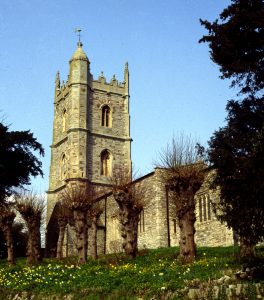An element of real church history appears in Effigy of the Cloven Hoof. As I mentioned in my posting of February 24, 2020, the reformer John Wycliffe served as the Prebend of Aust for thirteen years which corresponded to the time when Lady Apollonia and her second husband, Edward Aust, would have been raising their five sons in their manor just across the road from the parish church which is shown in the picture above. That earlier posting explained that John Wycliffe (1330?-1384), as Prebend of Aust, had the living or income of the Aust church. He, as an Oxford scholar, would have been largely absent from Aust, hiring a prelate to perform clerical duties, but I could not resist writing this real-life character into my story.
In my fictional account, Lady Apollonia and her family met Wycliffe in Aust when her boys were young, and one of them, Thomas, spent time with the scholar, helping with his dog. Thomas, who went on to become a priest in Axbridge, Somerset, later in life reveals to his mother the influence Wycliffe had in his decision as a young man to enter the priesthood. This revelation was news to Lady Apollonia when she heard it in 1400.
 I emphasized Wycliffe’s contribution of the first translation of the Bible into the English of his day in my posting of February 24. He believed in making the Bible available in the vernacular language because of his belief in the importance of the scriptures to our personal faith. He personally translated the four gospels into English from the Latin Vulgate and may have translated the whole New Testament. A drawing depicting the great man is shown on the left. His associates completed the task of translating the Bible from the Latin of the Vulgate into English, completing the Old Testament by the year of his death in 1384. Modifications by his assistant, John Purvey, appeared in 1388 and 1395.
I emphasized Wycliffe’s contribution of the first translation of the Bible into the English of his day in my posting of February 24. He believed in making the Bible available in the vernacular language because of his belief in the importance of the scriptures to our personal faith. He personally translated the four gospels into English from the Latin Vulgate and may have translated the whole New Testament. A drawing depicting the great man is shown on the left. His associates completed the task of translating the Bible from the Latin of the Vulgate into English, completing the Old Testament by the year of his death in 1384. Modifications by his assistant, John Purvey, appeared in 1388 and 1395.
In that earlier posting, I did not point out that Wycliffe’s overall role as a reformer of the medieval church happened more than a century before Martin Luther, but that reforming role was a significant contribution, in addition to his translation of the Bible.
The wealth and corruption of the Roman church were of great concern to Wycliffe. He attacked the privileged status of the clergy as well as the luxury and pomp of local bishops and their land-owning lordships. It is hard for us to realize the enormous wealth of many of the English churches and monasteries at the time of Effigy of the Cloven Hoof.
Wycliffe’s writings in Latin greatly influenced the philosophy and teachings of the Czech reformer John Hus a couple of generations later. Wycliffe’s followers became known as Lollards and reference to these followers appear from time to time in several of my novels. The body of Wycliffe himself was dug up a half century after his death and burned as that of a heretic.
